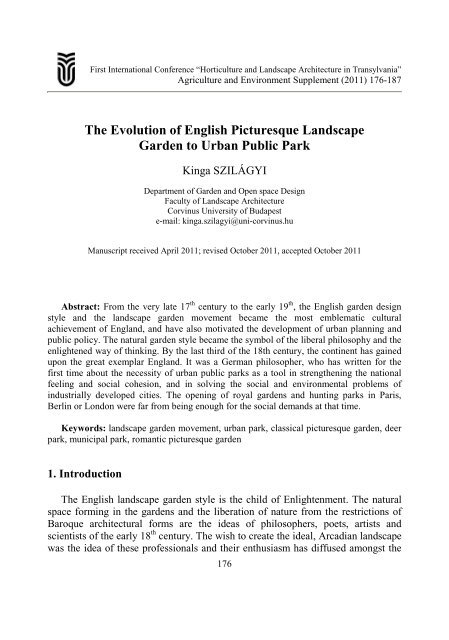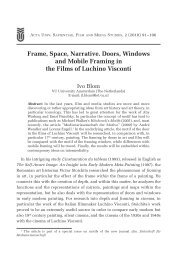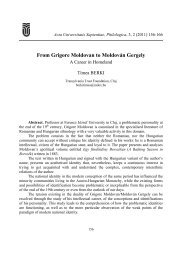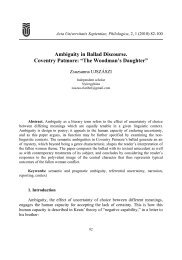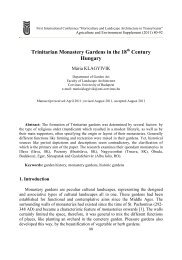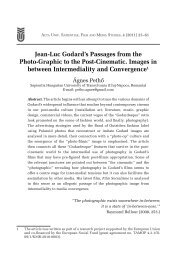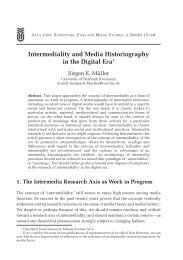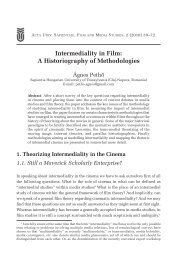The Evolution of English Picturesque Landscape Garden to Urban ...
The Evolution of English Picturesque Landscape Garden to Urban ...
The Evolution of English Picturesque Landscape Garden to Urban ...
Create successful ePaper yourself
Turn your PDF publications into a flip-book with our unique Google optimized e-Paper software.
First International Conference “Horticulture and <strong>Landscape</strong> Architecture in Transylvania”<br />
Agriculture and Environment Supplement (2011) 176-187<br />
<strong>The</strong> <strong>Evolution</strong> <strong>of</strong> <strong>English</strong> <strong>Picturesque</strong> <strong>Landscape</strong><br />
<strong>Garden</strong> <strong>to</strong> <strong>Urban</strong> Public Park<br />
Kinga SZILÁGYI<br />
Department <strong>of</strong> <strong>Garden</strong> and Open space Design<br />
Faculty <strong>of</strong> <strong>Landscape</strong> Architecture<br />
Corvinus University <strong>of</strong> Budapest<br />
e-mail: kinga.szilagyi@uni-corvinus.hu<br />
Manuscript received April 2011; revised Oc<strong>to</strong>ber 2011, accepted Oc<strong>to</strong>ber 2011<br />
Abstract: From the very late 17 th century <strong>to</strong> the early 19 th , the <strong>English</strong> garden design<br />
style and the landscape garden movement became the most emblematic cultural<br />
achievement <strong>of</strong> England, and have also motivated the development <strong>of</strong> urban planning and<br />
public policy. <strong>The</strong> natural garden style became the symbol <strong>of</strong> the liberal philosophy and the<br />
enlightened way <strong>of</strong> thinking. By the last third <strong>of</strong> the 18th century, the continent has gained<br />
upon the great exemplar England. It was a German philosopher, who has written for the<br />
first time about the necessity <strong>of</strong> urban public parks as a <strong>to</strong>ol in strengthening the national<br />
feeling and social cohesion, and in solving the social and environmental problems <strong>of</strong><br />
industrially developed cities. <strong>The</strong> opening <strong>of</strong> royal gardens and hunting parks in Paris,<br />
Berlin or London were far from being enough for the social demands at that time.<br />
Keywords: landscape garden movement, urban park, classical picturesque garden, deer<br />
park, municipal park, romantic picturesque garden<br />
1. Introduction<br />
<strong>The</strong> <strong>English</strong> landscape garden style is the child <strong>of</strong> Enlightenment. <strong>The</strong> natural<br />
space forming in the gardens and the liberation <strong>of</strong> nature from the restrictions <strong>of</strong><br />
Baroque architectural forms are the ideas <strong>of</strong> philosophers, poets, artists and<br />
scientists <strong>of</strong> the early 18 th century. <strong>The</strong> wish <strong>to</strong> create the ideal, Arcadian landscape<br />
was the idea <strong>of</strong> these pr<strong>of</strong>essionals and their enthusiasm has diffused amongst the<br />
176
<strong>The</strong> <strong>Evolution</strong> <strong>of</strong> <strong>English</strong> <strong>Picturesque</strong> <strong>Landscape</strong> <strong>Garden</strong> <strong>to</strong> <strong>Urban</strong> Public Park 177<br />
highly educated Whig society. <strong>The</strong>ir liberal way <strong>of</strong> thinking and their independence<br />
from the royal court were reflected in the love <strong>of</strong> free growing nature.<br />
However, from the late 18th century the culture <strong>of</strong> ideal landscapes also<br />
appeared as a practical <strong>to</strong>ol in social coherence in order <strong>to</strong> realise the great ideas <strong>of</strong><br />
the French Revolution. This is the reason why we have <strong>to</strong> call the <strong>English</strong><br />
landscape garden a movement and not only a style, which attracted and reformed<br />
the gardens, landscapes and even the urban structure <strong>of</strong> Britain and the Continent,.<br />
<strong>The</strong> idea <strong>of</strong> social coherence added a new content <strong>to</strong> the garden design theory and<br />
resulted in the birth <strong>of</strong> the first public gardens and parks in England and on the<br />
Continent as well.<br />
2. Materials and Methods<br />
<strong>The</strong> his<strong>to</strong>ry <strong>of</strong> garden art, the pr<strong>of</strong>essional literature <strong>of</strong> <strong>English</strong> landscape garden<br />
movement have many keynote, important theoretical publications, which <strong>of</strong>fer the<br />
possibility <strong>to</strong> analyze the development <strong>of</strong> landscape gardens <strong>to</strong> urban parks step by<br />
step. <strong>The</strong> birth <strong>of</strong> <strong>English</strong> garden, the classical and romantic picturesque garden<br />
style is well published not only in the British but in the continental and the<br />
American literature as well. Among others, the publications and books <strong>of</strong> Nicolaus<br />
Pevsner, Miles Hadfield, John Dixon Hunt, Charles Quest-Ritson, David Jacques,<br />
Tom Turner and Timothy Mowl dealt very detailed with the social background <strong>of</strong><br />
the so-called landscape garden movement. [1] [5] [6]. Besides the British Island,<br />
the continental development proved <strong>to</strong> be very important where contemporary<br />
writers, like the German philosopher, C.L. Hirschfeld [2] called the attention <strong>to</strong> the<br />
social aspects <strong>of</strong> the industrial and urban development <strong>of</strong> the 18 th century and<br />
suggested the establishment <strong>of</strong> public parks in the urban fabric. <strong>The</strong> German<br />
pr<strong>of</strong>essional literature, first <strong>of</strong> all the publications <strong>of</strong> Dieter Hennebo in the 1970s<br />
underlined the importance <strong>of</strong> multifunctional public parks. <strong>The</strong> research <strong>of</strong><br />
Dorothee Nehring was the very first <strong>to</strong> introduce the German born Henrik<br />
Nebbien’s work, among them the City Park <strong>of</strong> Budapest as one <strong>of</strong> the first public<br />
parks on the continent [4].<br />
3. Results and discussions<br />
From the end <strong>of</strong> 17th century, the wealthy Whig families laid a stress on<br />
spiritual and educational development, besides the growing economical and<br />
political independence from the royal court. <strong>The</strong> regularly organised grand <strong>to</strong>urs <strong>to</strong><br />
Italy proved <strong>to</strong> be flourishing as study <strong>to</strong>urs and also as collection <strong>to</strong>urs. Many<br />
landscape paintings <strong>of</strong> the famous landscape painters have been saved and<br />
transported <strong>to</strong> the castles <strong>of</strong> the <strong>English</strong> noble society <strong>of</strong> England. <strong>The</strong> treasures <strong>of</strong>
178 K. Szilágyi<br />
ancient and renaissance architecture <strong>of</strong> Italy inspired the most talented members <strong>of</strong><br />
the high society <strong>to</strong> develop their own estates and <strong>to</strong> create the ideal landscape. Lord<br />
Burling<strong>to</strong>n, an amateur architect and talented artist, William Kent met in Italy and<br />
their friendship proved <strong>to</strong> be flourishing according <strong>to</strong> the first epoch <strong>of</strong> landscape<br />
garden movement.<br />
<strong>The</strong> early 18 th century brought an intensive development <strong>of</strong> estates with the socalled<br />
enclosure, when common lands have been confiscated <strong>to</strong> have larger deer<br />
parks and pastures. As a result <strong>of</strong> growing pasturelands, the woodlands<br />
disappeared. <strong>The</strong> few, only remained forests became highly estimated. <strong>The</strong> love <strong>of</strong><br />
Nature played an important role in the very first landscape garden <strong>of</strong> Sir William<br />
Temple, who heard and read about the most natural landscape forms <strong>of</strong> Chinese<br />
gardens. However, no paintings or decorated books <strong>of</strong> the Chinese garden culture<br />
were on the market, but only the masterpieces <strong>of</strong> Chinese decorative art, paintings<br />
and porcelains. Temple, a fanatic collec<strong>to</strong>r <strong>of</strong> porcelains, learnt the natural space<br />
forming from the decorations <strong>of</strong> these masterpieces.<br />
Figure 1: <strong>The</strong> Moor Park in the late 18 th century with Baroque parterres and fine serpentine<br />
water forms in the side-garden. <strong>The</strong> landscape is dominated by deer parks<br />
<strong>The</strong> other example <strong>of</strong> the irregular or the so-called serpentine form garden<br />
design is also linked <strong>to</strong> a nice forest. Charles Howard, 3rd Earl <strong>of</strong> Carlisle, a<br />
wealthy British statesman and member <strong>of</strong> the peerage <strong>of</strong> England, in 1699<br />
commissioned a new Baroque mansion, Castle Howard, in Yorkshire, England <strong>to</strong><br />
the design <strong>of</strong> Sir John Vanbrugh. He rejected the regular way <strong>of</strong> opening up the<br />
wood with Baroque vues, and established instead a natural form space system and<br />
garden ways along the Wray Wood <strong>of</strong> Castle Howard. <strong>The</strong> 70 hectares large wood<br />
kept its wild and natural character, because only small architectural elements have<br />
been fitted in the clearings, while the emblematic Temple <strong>of</strong> four winds planned by
<strong>The</strong> <strong>Evolution</strong> <strong>of</strong> <strong>English</strong> <strong>Picturesque</strong> <strong>Landscape</strong> <strong>Garden</strong> <strong>to</strong> <strong>Urban</strong> Public Park 179<br />
Vanbrugh was constructed on the corner <strong>of</strong> the forest so as not <strong>to</strong> compete with<br />
Nature, but <strong>to</strong> amend it. Stephen Switzer, the philosopher <strong>of</strong> the early 18 th century<br />
called the design <strong>of</strong> Wray Wood the most natural and polite space forming.<br />
<strong>The</strong> irregular and serpentine form gardens designed by amateurs, by poets, like<br />
Alexander Pope or scientists, like Addison, or statesmen and architects, like Lord<br />
Carlisle and Vanbrugh, were only the first steps in the landscape garden movement.<br />
<strong>The</strong> gardens <strong>of</strong> the new philosophy gave freedom <strong>to</strong> the vegetation and the strict<br />
formal structures. However, the almost half a century long first period <strong>of</strong> <strong>English</strong><br />
garden movement did not bring <strong>to</strong>o many new garden creations. Only some<br />
wealthy and highly educated Whig landlords started reconstruction projects on<br />
their home estates.<br />
<strong>The</strong> most talented designer <strong>of</strong> the first, the so-called classical picturesque<br />
garden period, William Kent, was originally a coach painter, then a painter and<br />
scene-painter. Kent learned the classical landscape painting in Italy, then arrived<br />
home <strong>to</strong> England <strong>to</strong> utilise and improve his new knowledge in a three-dimensional<br />
design technique. His most well known masterpieces are Claremont, Eus<strong>to</strong>n,<br />
Rousham and S<strong>to</strong>we, where he worked as a garden designer and an architect as<br />
well. His garden designs are three-dimensional paintings, theatrical scenes in<br />
Nature, created with Nature therefore I would call Kent’s gardens the “scenescape”<br />
gardens. All separated and interlinked garden scenes tell about mythological<br />
or classical s<strong>to</strong>ries. His gardens are for contemplation and thinking, for enjoying<br />
life and harmony with Nature.<br />
Kent’s designs are deeply integrated in the landscape and so is his architecture.<br />
His building and all his built garden elements are composed on classical<br />
architectural studies in a fine harmony with the traditional, strong <strong>English</strong><br />
architectural forms. Kent’s buildings are deeply rooted in the <strong>English</strong> landscape,<br />
but also refer <strong>to</strong> the his<strong>to</strong>ry <strong>of</strong> architecture with many direct and hidden references.<br />
Figure 2: <strong>The</strong> garden scene <strong>of</strong> the Venus vale with water ponds, cascades and wooden<br />
space walls in the Rousham garden designed by William Kent (early 18 th century).
180 K. Szilágyi<br />
<strong>The</strong> independent life from the royal court demanded not only strong economical<br />
background but also the wish <strong>to</strong> fulfil the cultural, social organising roles<br />
traditionally represented by the royal court. Besides the classical quotations telling<br />
about the s<strong>to</strong>ries and heroes <strong>of</strong> mythology and about the everlasting human values,<br />
the national commitment is also reflected in the gardens. <strong>The</strong> temple <strong>of</strong> British<br />
worthies in the S<strong>to</strong>we garden is a gallery <strong>of</strong> spiritual and royal giants who played<br />
an important role in the political and cultural development <strong>of</strong> England. Among the<br />
busts there are only a very few royal personalities, like Queen Elisabeth or King<br />
William III, but there are poets like Mil<strong>to</strong>n, Pope and Shakespeare, there are<br />
scientists, like Bacon, New<strong>to</strong>n. We can admire the statue <strong>of</strong> Captain Drake and the<br />
Palladian architecture <strong>of</strong> Inigo Jones. <strong>The</strong> gallery <strong>of</strong> S<strong>to</strong>we is more than a portraits<br />
gallery; it is the first sign <strong>of</strong> national or patriotic philosophy.<br />
Figure 3: <strong>The</strong> Temple <strong>of</strong> British Worthies (W. Kent, early 18 th century) is the gallery <strong>of</strong><br />
spiritual and royal giants <strong>of</strong> national importance. (Pho<strong>to</strong> made by Imre Jámbor)<br />
<strong>The</strong> classical picturesque gardens are not easy <strong>to</strong> understand. <strong>The</strong>y have a wellframed<br />
cultural program and message, therefore they can be fully taken in only by<br />
learned people who are educated in ancient mythology and classical arts –<br />
otherwise small <strong>to</strong>uristic books helped visi<strong>to</strong>rs <strong>to</strong> understand and read the words <strong>of</strong><br />
the architectural citations fitted or hidden in the garden in the open air stage-scenes.<br />
<strong>The</strong> guidebooks <strong>of</strong> S<strong>to</strong>we and the Leasows, the garden <strong>of</strong> the poet Shens<strong>to</strong>ne,<br />
<strong>of</strong>fered the physical and spiritual way <strong>to</strong> walk around the garden and understand its<br />
ideal landscape. <strong>The</strong> classical picturesque gardens belonged <strong>to</strong> the learned,<br />
accomplished, most polite high-class members.<br />
By the mid-18 th century, the few classical picturesque gardens <strong>of</strong> the Whig<br />
aris<strong>to</strong>crats’ became well known and also desired assets. <strong>The</strong>se gardens were<br />
expensive <strong>to</strong> build and <strong>to</strong> maintain. <strong>The</strong> economical aspects did not play an<br />
important role in their development. <strong>The</strong>y were luxurious, magnificent creations <strong>of</strong><br />
the new garden art talking about spirit, human values, culture and about wealth, in
<strong>The</strong> <strong>Evolution</strong> <strong>of</strong> <strong>English</strong> <strong>Picturesque</strong> <strong>Landscape</strong> <strong>Garden</strong> <strong>to</strong> <strong>Urban</strong> Public Park 181<br />
a very sophisticated way. <strong>The</strong> turn arrived with the figure <strong>of</strong> Lancelot Brown who<br />
started as the talented student <strong>of</strong> Kent. However, he was much more a gardener<br />
than a three-dimensional painter was. He became the most important master <strong>of</strong><br />
garden design <strong>of</strong> his time. His special design method reflected the practical way <strong>of</strong><br />
thinking, the knowledge <strong>of</strong> economical and ecological aspects <strong>of</strong> garden design. He<br />
was famous for his design method, which started with a walk around the estate <strong>to</strong><br />
study the landscape, the ecological systems and the farm economical possibilities.<br />
He insisted on Kent’s design school as his gardens kept the picturesque idea. But<br />
he added the economical sustainability as a special aspect <strong>of</strong> garden design, which<br />
resulted in a new phenomenon in the <strong>English</strong> garden movement, namely the<br />
landscape park. <strong>The</strong> estates developed by Brown, became financially manageable,<br />
they produced significant pr<strong>of</strong>it out <strong>of</strong> farming and sylviculture, out <strong>of</strong> huge deer<br />
parks and orchards. Brown’s design and management system was easy <strong>to</strong> learn and<br />
follow. <strong>The</strong> main <strong>to</strong>ols were the meandering beltways along the surrounding<br />
forests, which produced timber and fruit and small game. <strong>The</strong> serpentine form<br />
water <strong>to</strong>gether with the clump form and discrete plantations used <strong>to</strong> be the<br />
consistent and compulsory elements <strong>of</strong> the Brownian landscape park. Besides<br />
S<strong>to</strong>we, probably Petworth and Bowood could be mentioned as the largest scaled<br />
creations out <strong>of</strong> the almost 200 Brownian parks.<br />
Figure 4: <strong>The</strong> Petworth garden, one <strong>of</strong> Brown’s first masterpieces, is a huge and rich<br />
deer park with serpentine form water bodies, clumps and undulating landscape [7]<br />
<strong>The</strong> ideal landscape <strong>of</strong>fered by Brown did not demand the knowledge <strong>of</strong><br />
classical culture <strong>to</strong> understand it. <strong>The</strong> refined artistic design theory <strong>of</strong> Kent’s<br />
gardens was over. <strong>The</strong> classical architectural elements remained simple stress<br />
points and eyecatcher for the visi<strong>to</strong>rs walking around without having a special<br />
meaning or intellectual program. Brown has moved a big step in<strong>to</strong> the direction <strong>of</strong><br />
popularity and self-evidence. <strong>The</strong> fact that Brown was appointed in 1764 a royal<br />
gardener by George III, made the Brownian gardens even more popular and<br />
demanded. <strong>The</strong> pr<strong>of</strong>itable deer-park system <strong>of</strong> the landscape parks opened the<br />
market for the less wealthy society and the royalist Tory estate owners had their old
182 K. Szilágyi<br />
gardens renewed by Brown or his followers or other talented gardeners. In this<br />
way, a large quantity <strong>of</strong> landscape gardens were developed in the second half <strong>of</strong> the<br />
18th century, which has reformed the completely <strong>English</strong> rural landscape.<br />
Owing <strong>to</strong> the urban and industrial development, the London urban environment<br />
and the concentrated population needed more open space in the urban fabric. From<br />
the mid 17th century, some royal gardens were opened for public use, at least for<br />
the high and mid level society, but they did not prove <strong>to</strong> be enough for the urban<br />
population. Besides the half-open royal parks, many privately developed pleasure<br />
gardens could be found mainly in London <strong>to</strong> <strong>of</strong>fer some open air recreation<br />
possibility for the residents.<br />
Figure 5: <strong>The</strong> Marylebone garden, one <strong>of</strong> the most well known<br />
pleasure gardens <strong>of</strong> London (18 th -19 th c.)<br />
<strong>The</strong> social strain cried for remedy. <strong>The</strong> turn happened not in England, but on the<br />
continent, almost parallel with the Great French Revolution. <strong>The</strong> ideology <strong>of</strong><br />
freedom, equality and fraternity has inspired the garden theory as it can be seen in<br />
Hirschfeld’s works. Christian Cay Lorenz Hirschfeld was a Danish philosopher<br />
who was confident in the huge embellishing power <strong>of</strong> Nature. He considered the<br />
landscape parks as possible social melting pots for every social class <strong>to</strong> meet and<br />
get <strong>to</strong> know each other. [2] <strong>The</strong> ideology <strong>of</strong> Hirschfeld impressed many gardeners<br />
in the German regions, among others Ludwig Sckell, the talented main gardener <strong>of</strong><br />
the Schwetzingen gardens. Sckell studied garden design directly in England, but he<br />
was a fanatic <strong>of</strong> Hirschfeld’s theory. In 1789 Prince Karl, the Prussian monarch<br />
asked Sckell <strong>to</strong> develop the military recreation area along the Isar river in<strong>to</strong> a<br />
Volksgarten. <strong>The</strong> park was formed in a very Brownian style but it has been<br />
developed and supplemented with practical functions so as <strong>to</strong> supply a wide variety<br />
<strong>of</strong> open-air amusement for all public classes. <strong>The</strong> Englischer Park was directly<br />
planned for the purposes <strong>of</strong> a city park, but the order came from the monarch. After
<strong>The</strong> <strong>Evolution</strong> <strong>of</strong> <strong>English</strong> <strong>Picturesque</strong> <strong>Landscape</strong> <strong>Garden</strong> <strong>to</strong> <strong>Urban</strong> Public Park 183<br />
the French Revolution, the idea <strong>to</strong> give more space and freedom <strong>to</strong> the people was<br />
more than an obvious step from an open-minded monarch. <strong>The</strong> park was very<br />
important in its urban context as well, because it served as a green link <strong>to</strong> the<br />
traditional, his<strong>to</strong>rical <strong>to</strong>wn centre and the principal gardens.<br />
Figure 6: <strong>The</strong> Englischer Garten in München is an urban park opened<br />
by the monarch for public recreational use (Source: [3])<br />
By the turn <strong>of</strong> the 18 th -19 th century there were opened royal gardens and parks<br />
given as urban recreational open-air areas <strong>to</strong> the public society <strong>of</strong> the large<br />
industrialised and urbanised cities. However, the very first real public park, the socalled<br />
municipal park was developed in Hungary in the capital, Pest-Buda, as it<br />
was called at that time.<br />
<strong>The</strong> peri-urban landscapes lying at the eastern border <strong>of</strong> Pest used <strong>to</strong> be a royal<br />
hunting field in the medieval times, and later remained abandoned. By the mid 18th<br />
century, the reclamation <strong>of</strong> the waste site became necessary and the necessary<br />
plantation was started by the municipality <strong>of</strong> Pest with acacias and mulberry trees.<br />
Attempts were made later <strong>to</strong> develop the area in<strong>to</strong> a privately sponsored pleasure<br />
garden, but this project proved <strong>to</strong> be unsuccessful. By the end <strong>of</strong> the 18th century,<br />
the city <strong>of</strong> Pest regained the ownership, and the newly reformed Embellishment<br />
Commission under the leadership <strong>of</strong> Joseph Palatine accepted the wish <strong>of</strong> the<br />
residents and decided <strong>to</strong> develop an urban park, the so-called Volksgarten, or City<br />
Park (Városliget in Hungarian).
184 K. Szilágyi<br />
Figure 7: <strong>The</strong> site <strong>of</strong> the City Park in Pest before the construction <strong>of</strong> the very first<br />
municipal park (Drawing by H. Nebbien, 1813 [4])<br />
In 1813, the Commission organized a competition, which was won by Heinrich<br />
Nebbien, a German landscape designer, and manager, who educated himself in<br />
landscape gardens <strong>of</strong> England. Nebbien developed his plan between 1813 and<br />
1816. His plan was born in the spirit <strong>of</strong> Brown’s landscape parks but he also<br />
integrated the social ideas <strong>of</strong> Hirschfeld. <strong>The</strong> large grass meadows with the circular<br />
beltway and the serpentine form waters, <strong>to</strong>gether with the clump formed plantation,<br />
reflect a strong emphasis <strong>of</strong> the <strong>English</strong> landscape parks. Owing <strong>to</strong> the low budget<br />
<strong>of</strong> the council, he <strong>of</strong>fered his honorary for the construction <strong>to</strong>gether with many<br />
citizens who were enthusiastic about the urban public park. Unfortunately, the<br />
collected money was not enough, therefore the construction was not fully finished.<br />
In spite <strong>of</strong> this fact, the Városliget, with its grandiose classical and romantic<br />
picturesque character was the very first municipal park, and it is going <strong>to</strong> have its<br />
200 years birthday in 2013.<br />
Figure 8: <strong>The</strong> City Park designed by H. Nebbien in a<br />
classical-romantic landscape park form [4]
<strong>The</strong> <strong>Evolution</strong> <strong>of</strong> <strong>English</strong> <strong>Picturesque</strong> <strong>Landscape</strong> <strong>Garden</strong> <strong>to</strong> <strong>Urban</strong> Public Park 185<br />
Nebbien added the national aspect and the functionality <strong>to</strong> the concept <strong>of</strong> the<br />
renewal <strong>of</strong> the park and its adaptation <strong>to</strong> the public use. <strong>The</strong> main entrance opened<br />
at the end <strong>of</strong> the avenue leading out <strong>of</strong> the city <strong>to</strong> the periphery. Owing <strong>to</strong> the<br />
typical dense and levelled plantation, the park gate became a strong architectural<br />
and landscape architectural element. <strong>The</strong> sustainability <strong>of</strong> the urban park was also<br />
an idea, which had its origin in the Brownian design theory. But this economical<br />
aspect was combined with the ideas <strong>of</strong> a social supply in Nebbien’s plan. <strong>The</strong><br />
multifunctional park <strong>of</strong>fered various recreational possibilities at that time. Besides<br />
opportunities for riding and walking or simply enjoying nature, there were dance<br />
halls and sport arenas for athletes.<br />
Figure 9: Nebbien’s plan for the main entrance and the Rondo<br />
with the concave form looking <strong>to</strong> the park from the avenue [4]<br />
With Hirschfeld’s theory in his mind Nebbien intended <strong>to</strong> develop the public<br />
park as an educational and cultural scene, therefore he designed statues, heroic<br />
monuments <strong>of</strong> the national his<strong>to</strong>ry – some similarity with the British worthies – in<br />
a fine classical architectural form. <strong>The</strong> garden ways and park roads were designed<br />
in a separated system as Hirschfeld <strong>of</strong>fered it: alleys and hedges with a nice<br />
concave space form divided the riding path and the walking path.<br />
Figure 10: Nebbien’s plan for the separated way<br />
system with concave green space walls [4]<br />
In spite <strong>of</strong> many efforts for collecting money for the development <strong>of</strong> the park,<br />
the budget proved <strong>to</strong> be very low and the construction remained unfinished. <strong>The</strong><br />
most important landscape elements were finished, like the elegant Rondo and the
186 K. Szilágyi<br />
islands <strong>to</strong>gether with the beltways. <strong>The</strong> plantation developed a lot as well. Not only<br />
Nebbien was enthusiastic about the city park, but also the inhabitants <strong>of</strong> Pest loved<br />
the park very much. Soon it became the most well known amusement and<br />
recreation place that was mentioned in many poems and songs.<br />
Figure 11: <strong>The</strong> City park with its romantic landscape (late 19 th century)<br />
We have started our grandiose <strong>to</strong>ur following the main steps <strong>of</strong> the development<br />
<strong>of</strong> the <strong>English</strong> garden movement from the Continent, from Italy <strong>to</strong> England, than<br />
back <strong>to</strong> the Continent. Turning back <strong>to</strong> the cradle <strong>of</strong> the landscape gardens and<br />
parks, we have <strong>to</strong> admit that owing <strong>to</strong> the more open space recreation possibilities<br />
given for the London citizens in the form <strong>of</strong> pleasure gardens and opened royal<br />
parks, the time for the development <strong>of</strong> a typical urban park came much later.<br />
Moreover, not even in London, but in another industrially developed city,<br />
Liverpool, where by the middle <strong>of</strong> the 19 th century the first <strong>English</strong> public park was<br />
born on the plans <strong>of</strong> Pax<strong>to</strong>n. Pax<strong>to</strong>n’s work proved <strong>to</strong> be much more important than<br />
<strong>to</strong> remain an urban park. It has won an international reputation by F.L. Olmstead,<br />
the crea<strong>to</strong>r <strong>of</strong> the word ‘landscape architecture’, who imported the landscape park<br />
idea <strong>to</strong> America.<br />
How the American park design developed and affected the European, which is<br />
another s<strong>to</strong>ry.<br />
4. Conclusion<br />
<strong>The</strong> his<strong>to</strong>ry <strong>of</strong> urban public parks started with the liberation <strong>of</strong> Nature and the<br />
birth <strong>of</strong> <strong>English</strong> garden art. <strong>The</strong> <strong>English</strong> term ‘park’ originally meant a deer park.<br />
<strong>The</strong> 18 th century <strong>English</strong> landscape garden movement inspired by the new liberal
<strong>The</strong> <strong>Evolution</strong> <strong>of</strong> <strong>English</strong> <strong>Picturesque</strong> <strong>Landscape</strong> <strong>Garden</strong> <strong>to</strong> <strong>Urban</strong> Public Park 187<br />
philosophy and the love <strong>of</strong> classical arts transformed the deer parks <strong>of</strong> the aris<strong>to</strong>cratic<br />
society in<strong>to</strong> picturesque gardens or later in<strong>to</strong> landscape parks. In the meantime,<br />
gardens and parks became a necessity for the recreation <strong>of</strong> the urban population in<br />
the form <strong>of</strong> urban parks in the early 19th century. From the very first classical<br />
picturesque gardens, the design theory developed with involving the economical<br />
aspect in<strong>to</strong> the concept and making the <strong>English</strong> garden an economically manageable<br />
estate. <strong>The</strong> romantic picturesque gardens arrived at the strengthening middle society<br />
<strong>of</strong> the industrialised world, and last the urban parks became the social melting pots<br />
where people could gather <strong>to</strong> enjoy nature, fresh air and sunshine.<br />
First some royal or principal deer parks have been turned in<strong>to</strong> urban parks on<br />
the continent, later new public parks have been created integrating new public<br />
functions and simplified architectural forms in<strong>to</strong> the romantic landscape garden<br />
concept, so as <strong>to</strong> supply the increasingly populous urban society with sufficient<br />
recreational possibilities and gardens that are easy <strong>to</strong> understand. <strong>The</strong> very first<br />
strictly public park, the municipal park <strong>of</strong> Pest-Buda, the City Park is going <strong>to</strong> be<br />
200 years old in this decade. <strong>The</strong> overloaded and low-maintained park waits for the<br />
renewal, which should recall some elements <strong>of</strong> the once worldwide famous<br />
Nebbien’s concept both in its philosophy and in form.<br />
Acknowledgements<br />
Publishing <strong>of</strong> this article is supported by the TÁMOP 4.2.1.B-09.KMR-2010-0005.<br />
References<br />
[1] Mohl, Timothy (2000) Gentlemen & Players. <strong>Garden</strong>ers <strong>of</strong> the <strong>English</strong> <strong>Landscape</strong>.<br />
Sut<strong>to</strong>n Publishing Limited, pp. 115<br />
[2] Hirschfeld, Christian Cay Lorenz: <strong>The</strong>orie der Gartenkunst. Leipzig 1779–1785.<br />
Nachdruck: Olms, Hildesheim 1990<br />
[3] Volker Hannwacker: Friedrich Ludwig von Sckell. Der Begründer des Landschaftsgartens<br />
in Deutschland, Deutsche Verlagsanstalt, Stuttgart 1992<br />
[4] Nebbien, Heinrich: Ungarns Folks-Garten der Koeniglichen Frey Stadt Pesth (1816),<br />
ed. Dorothee Nehring (1981).<br />
[5] Galavics, Géza: Magyarországi angolkertek (<strong>Landscape</strong> <strong>Garden</strong>s in Hungary) (1999).<br />
[6] Szilágyi, Kinga: Az angolkerttől a városi parkig. (From <strong>English</strong> <strong>Landscape</strong> <strong>Garden</strong> <strong>to</strong><br />
<strong>Urban</strong> Park) 4D Tájépítészeti és Kertművészeti Folyóirat (4D Journal <strong>of</strong> <strong>Landscape</strong><br />
Architecture and <strong>Garden</strong> Art), 2009. 15. sz. P.14-26.<br />
[7] Vic<strong>to</strong>rian London - Publications - His<strong>to</strong>ry - Views <strong>of</strong> the Pleasure <strong>Garden</strong>s <strong>of</strong><br />
London, by H.A.Rogers, 1896


